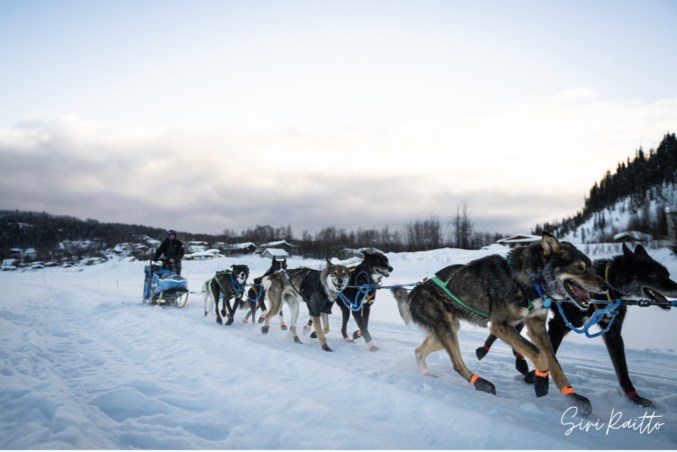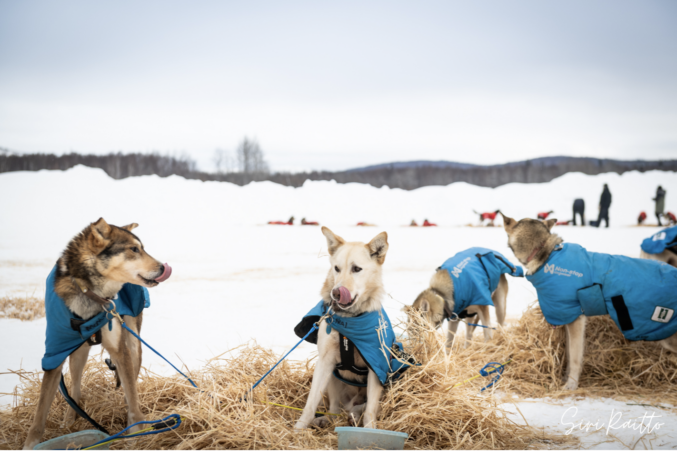Travis Beals is out of Ruby and soon to arrive in Galena. Matt Hall and Dallas Seavey are following approximately 30 and 40 miles back respectively. Travis is pondering where/when to take his 8-hour Yukon rest. Wisdom says take it while the dogs are running well.
Nic Petit is the only racer that hasn’t completed the 24, but he has only a few hours to go and will be out well before midnight. Then we’ll start seeing the check marks in the 8 hour column on the race stat sheet as mushers spend a little extra time in either Ruby, Galena, Nulato or Kaltag.
Looking at run times from Cripple to Ruby, Jason Mackey covered the 70 miles in 10 hours and 49 minutes with his team of 14 dogs. He as well as all the other mushers are liking the lower temperatures and the faster trail thanks to those lower temps.
There are just two teams that have the full string of 16 dogs – Severin Cathry and Lara Kittelson. Both rookies are running in the back of the pack.
Race Judge Sebastian Schnuelle, commented on checkpoint efficiency in an interview with Insider KattiJo Deeter. He said that when the front runners come into a checkpoint they are very focused, really dialed in. Every movement has a purpose. Rookies haven’t gained that efficiency as of yet, but they are learning the routine during the race. More efficiency in caring for the dogs allows the mushers a little more sleep. He particularly mentioned how Lara Kittelson has improved in getting her checkpoint chores done much quicker from when he saw her in Finger Lake to now in McGrath.
Wally Robinson, currently in 12th position did his rookie run in 2001. Fellow rookies were Lance Mackey, Ryan Redington, Jessie Royer and Aliy Zirkle. Now 23 years later, Wally is back for his second run with the goal of getting Josh McNeal’s team to Nome. Definitely, the race has changed. Technology with the trackers makes the race more accessible to spectators. In 2001, Wally used a walkman and CD’s for music. What’s a walkman? Today’s mushers have the option of using sit down sleds.
Sebastian who ran his first race in 2005 added to the list of changes. The number of mushers is much smaller which makes for more room in the checkpoints and less wear on the trail. He also told Insider KattiJo that run times haven’t changed as much as running style. Long slower runs were common then but now runs are shorted and faster.
Sebastian says in his current role, the veterans don’t ask many questions but the rookies seek advice about dogs and the trail. He says, “As a judge, I’m also a coach.”
Robinson first ran dogs when living in Michigan. He moved to the last frontier and continued running dogs. Now, living in Nenena he’s changed hats in the dog lot from musher and racer to father and coach. He’s more focused now on helping his daughter Emily and son Stanley with their mushing careers. Emily is a three time Jr. Iditarod Champion which tied Tim Osmar’s accomplishment back in 1984. Stanley is also racing. In the recent Jr. Willow 100, Stanley took second to Champion Emily.
Travis Beals and his partner Sarah Stokey operate Turning Heads Kennel located in Seward. Both Travis and Sarah are Iditarod veterans. Travis says he began mushing before he was born. His mother had a sprint team and trained while she was expecting Travis. He did his first race at the age of four. He got his first job when he was 14 so he could purchase dogs to build his own team. In 2009 he ran the Jr. Iditarod at the age of 17 placing second behind Cain Carter who ran with Lance Mackey’s race team. Travis met Sarah in 2011 and together they established a successful summer tour operation. Beals is running his 10th Iditarod. He’s accumulated 3 top ten finishes since his rookie run in 2013. In 2019 Beals earned 5th place. His best northern route time came in 2016 – 9 days, 6 hours and 42 minutes.
With today being International Women’s Day, it’s fitting to remember and salute the great women of Iditarod for their achievements. From the first woman to finish Iditarod, Mary Shields (1974) followed closely by Lolly Medley to recent Red Lantern recipients Cindy Abbott, Victoria Hardwick, Kaci Murringer and Apayauq Reitan there are many strong women who compete equally with men in the Iditarod. Pam Flowers, Libby Riddles, Susan Butcher, DeeDee Jonrowe, Aliy Zirkle are only a few of the women who are Iditarod legends. Eleven women are on the trial for the 2024 Iditarod, six veterans – Anna Berington, Jessica Klejka, Mille Porsild, Jessie Royer, Amanda Otto and Paige Drobny and five rookies – Lara Kittelson, Anna Hennessy, Gabe Dunham, Erin Altemus and Josi Thyr. Celebrate these women and their outstanding achievements!



































